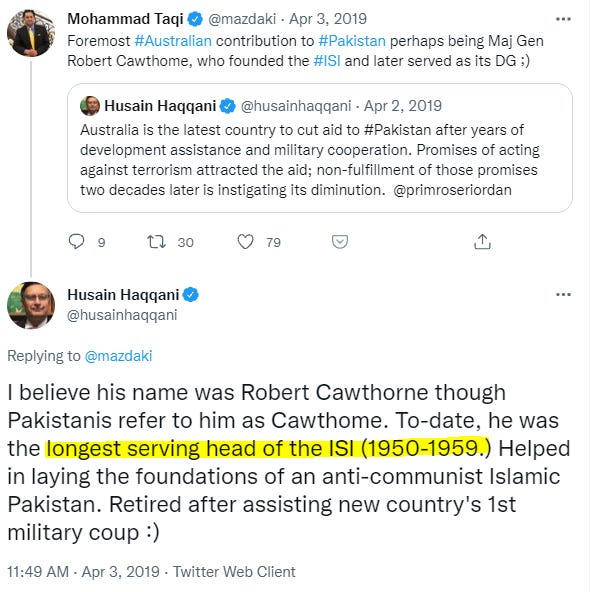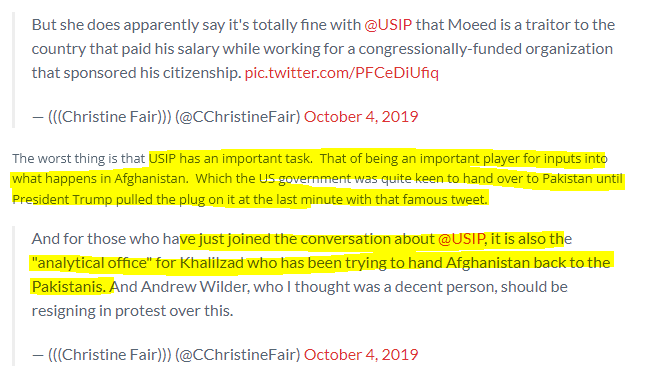Insightful newsletter of Drishtikone: Issue #320 - The World of ISI and R&AW
To understand the destinies of societies, one needs to understand how well the intelligence agencies of that country work. For battles are won before the Armies square against each other.
“I want to stand as close to the edge as I can without going over. Out on the edge you see all kinds of things you can't see from the center.” ― Kurt Vonnegut, Player Piano
There are two ways to see geopolitics. One, that it is an attempt to manage peace. The other is that it is an attempt to manage war. Perpetual war.
Actual battlefields may come to a pass at some point in time. When the mechanisms of balance have faltered. But the pressures on the nations and societies are continuous. Some battles are won without ever being fought with weapons. Like the one against USSR.
There are many powers who want to control other nations, specifically important ones, more closely and deeply. Sometimes, as in the case of Lal Bahadur Shastri’s death, (and even the attacks in media and elsewhere on the current Indian PM), independence can mean personalization of wars to take out the independence and enforce a covert colonial control.
In the modern world, espionage and counter-espionage operations are key to the survival and thriving of a country. The societies are not controlled or made safer by just the leaders or the forces, but more importantly by tools of control and counter-control in the field of espionage.
The story of the nations is decided not as much by its leaders as their Spy agencies. The spy agencies have been defining the destiny of the world for many centuries. Thomas Middleton wrote a play called “A Game of Chess” that was performed in Shakespearean Globe Theater in 1624. Its central theme was the machinations between the different religious forces of Protestants and Catholic Churches and how espionage was used to score victories against each other. These two movements created a war between two denominations of Christianity where intelligence was the key. (Source)
It is not what happens on the battlefield that necessarily decides the result of a battle. But what happens outside of the battlefield.
So today, let us delve into the spy agencies of Pakistan and India. ISI and R&AW. How they were created and how they have fared in the past seven decades.
Pakistan off to an early start
In the subcontinent, Pakistan got off to a start in intelligence very early in its life. Right after the 1948 Kashmir attack by the Pakistani regulars dressed as and leading the tribals, a war which Pakistanis lost badly. For every one Indian soldier, the Pakistanis lost 6 soldiers and finally retreated. British saw Pakistan’s defeat as a warning and wanted Pakistan to counter India from the get-go.
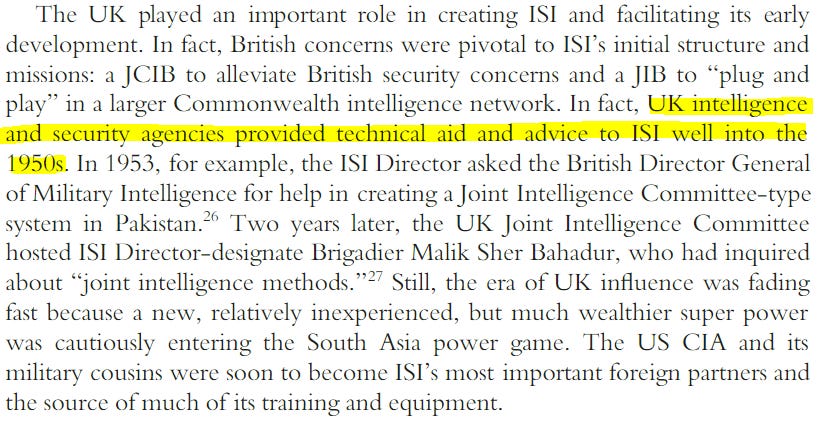
Major General Sir Robert Cawthorne (although spelled by many as Cawthome, his last name was actually Cawthorne) of the British Army was the man who started the ISI in 1948. He decided that unless Pakistan creates a force multiplier that could be used in manipulation and intrigue, Pakistanis could never stand up to the Indian Army.

The first office of ISI was built in Karachi, in a building opposite Zainab Market on Old Victoria Street.
Their main objective given to the recruits by Cawthorne: To weaken their mighty neighbor.
The large size, in Cawthorne’s assessment, made India weak. And its diversity in religion, languages, castes, etc could be used to make that happen.
Writer’s note: If you closely observe, you will notice that the British establishment during and post-partition, and the US establishment subsequently have backed Pakistan against all its endeavors against India.
He was the longest-serving ISI Chief who assisted the first military coup in Pakistan.
After the coup, Cawthorne’s ideology was reinforced by General Ayub Khan in 1958 when he created the Covert Action Division (CAD) which chalked up plans of backing and boosting the insurgency in India’s North East where tribes were already calling for autonomy.
Cold War and ISI-CIA quid-pro-quo
Ayub Khan understood that Cold War was a gold mine and had to be profited from. So, he went deeper into America’s camp. ISI was important to the CIA while the Indian intelligence always tried to catch the attention of Langley’s powerful.
For example, during the Cold War, when an American U2 bomber piloted by Gary Powers was shot down by the Soviets over the Urals in 1960, it had used the airbase at Peshawar.
The Soviets were especially dangerous if they knew the U-2 was coming. According to an official protest subsequently lodged with the US government by the foreign minister of Afghanistan, for violating their sovereign airspace on the way north, the Soviets provided an early warning of the spy plane’s incursion. It was around 6:20 on Sunday May 1, 1960 when a member of the crew pulled the ladder away and slammed the canopy shut. The pilot then locked it from the inside. As Francis Gary Powers taxied on to the runway out of Peshawar air base, Pakistan and carefully guided the U-2C, model 360, into the air, the J75/P13 engine roared with a distinctive whine. He never lost the thrill of hearing the familiar sound. (Source)
However, Ayub’s reign was not incident-free. Six Naval officers led by Faiz Hussain had plotted to assassinate the General. After which they intended to bring in their own set of conservative Islamist ministers. That ISI totally missed the plot which was unearthed by a local police DIG did not go well with Khan.
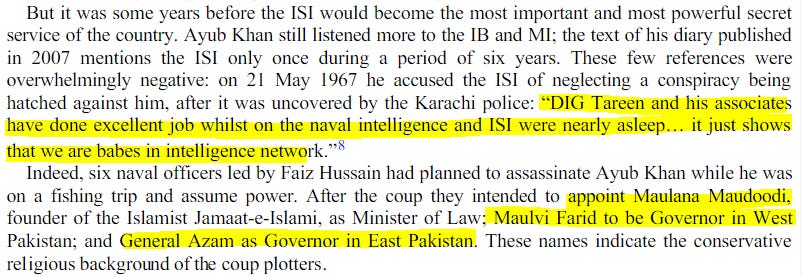
Thereafter, Ayub Khan pushed ISI into domestic surveillance.
ISI War Debacles against India
In 1965, however, ISI was working on war plans. ISI joined with the Military Intelligence to draw up a rather elaborate plan on the assumption that the Pakistani Army (dressed up as tribals of course!) would be greeted by the Kashmiri Muslims on the Indian side. Everything was predicated on that one major assumption. MI’s plan to do propaganda over radio failed as transmission equipment didn’t work. ISI’s contacts in India went underground. On the other hand, the Indian side arrested 4 Pakistani Army officers and made them spill the beans on All India Radio!
Operation Gibraltar (the brainchild of ISI) followed the approved Operation Grand Slam. Both failed.
When confronted, ISI Chief Riaz Hussain told Ayub Khan -
“All these years we were not doing our real work of counterintelligence, because we were too busy chasing your domestic political opponents” (Source: Faith, Unity, Discipline: The Inter-Service-Intelligence (ISI) of Pakistan by Hein G. Kiessling)
The next major event was the 1971 Division of Pakistan and the formation of Bangladesh.
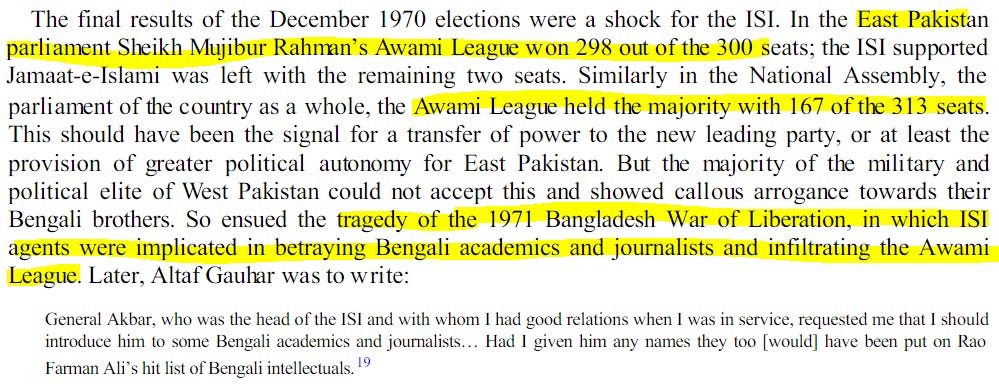
In the India-Pakistan War of 1971, Pakistan lost miserably. However, ISI was able to gather Indian Army Chief Sam Maneckshaw’s operational instructions that he issued in mid-August and share that with the President and the service Chiefs in Pakistan. Even though the Pakistan Army had prior information of the Indian formations and combat instructions, Pakistan lost the war and surrendered!
That was how strong the Indian Army’s victory was! It beat an enemy despite the fact that it had all its formations and instructions to act upon.
The Indian Spy Agency - Research and Analysis Wing (R&AW) - a name selected by the then Cabinet Secretary DS Joshi - was formed on September 21, 1968. Its motto was धर्मो रक्षति रक्षितः - Dharma Protected, Protects. The 1962 Sino-Indian war and the 1965 India-Pakistan war had exposed gaps in intelligence gathering undertaken by the Intelligence Bureau, which handled all the espionage work until then. RAW's first director was Rameshwar Nath Kao (RN Kao).
Btw, the Russians had also infiltrated the Pakistan establishment in the 1970s during the Cold War in a big way.
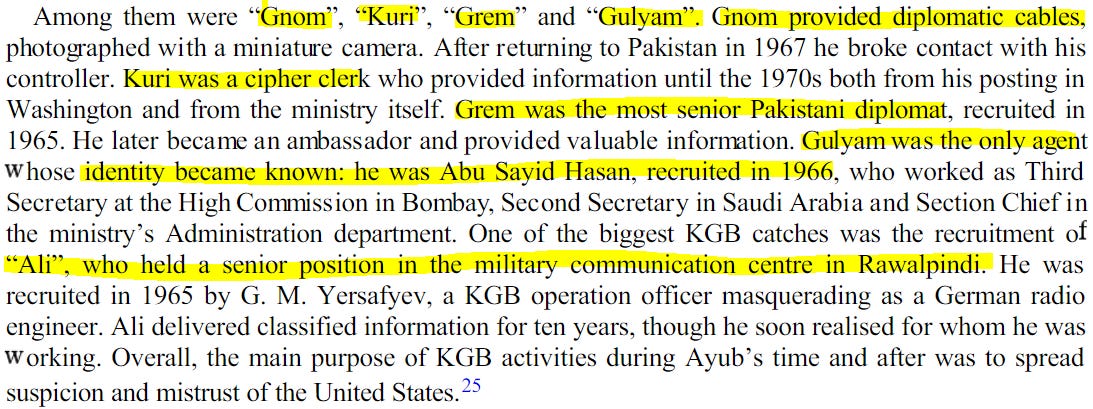
The Ganga Hijacking and the 1971 War
When it comes to the operations that ISI and RAW have been involved in against each other, the one that stands out was Indian Airlines flight “Ganga” Hijacking in 1971.
Briefly: an Indian R&AW agent Hashim Qureshi worked with BSF to infiltrate PoK and the organization Al Fatah, which was a Pak-sponsored terrorist organization. However, there Qureshi flipped. He was sent back to India to help hijack a plane from India. He came back but was caught by BSF and cracked. From here started a reverse espionage game at retaliation. RAW and BSF prepped Qureshi to work for them instead. An old IA plane, out of service by then was brought out and used as the IA flight Ganga, which Hashim Qureshi and his cousin Ashraf Qureshi hijacked. When they landed, they demanded the release of the 36 Al Fatah terrorists in an Indian jail. Qureshi got political asylum and hailed as a freedom fighter in Pakistan and became a hero with a special call from ZA Bhutto! The passengers were freed eventually and they came back to India by bus and the plane was burned by Pakistan. Meanwhile, India had announced how Pakistan Government was behind the hijacking and subsequent actions by them confirmed that to the wider global community.
Why did R&AW do this elaborate plan?
Because more significantly Indian government had banned all Pakistani flights over India due to this incident. So, the Pakistani civil flights which were being used to transport troops and arms as well - now had to go around India to reach Bangladesh. This slowed the troop build-up by Pakistan for their war response. This is the weakness that FM Sam Maneckshaw’s Army used to beat the Pakistanis.
Listen to the inimitable Shams describe this whole episode.
R&AW’s downfall and turnaround
Even though some of the operations and signatures of R&AW operatives have appeared over time, R&AW has been very secretive about its work and operations.
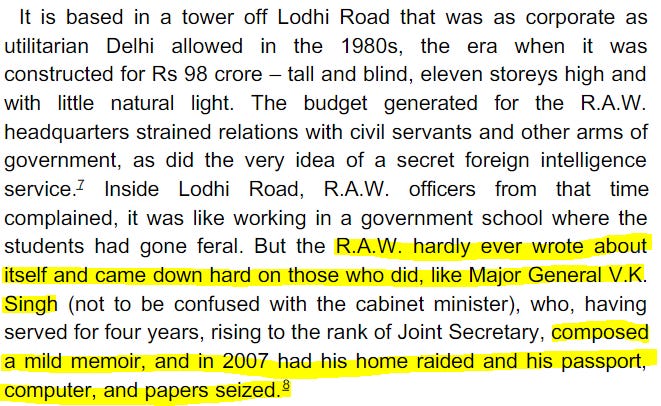
But it was the decade of the 1980s that created the biggest chasm between R&AW and ISI. While ISI was flush with money, equipment, and training from the US and the Saudis, the Indian counterpart was spiraling into total chaos.
In early 1980, a showdown between Counter-Intelligence Service (CIS) and RAW occurred. R&AW officers had gheraoed the CIS Deputy Director MD Dittia and shouted slogans and turned abusive.

R&AW began to shrink and become weak. Meanwhile, ISI was executing the plan for Khalistan.
It was not until 1987 that things turned around for R&AW. That was when R&AW got its new chief Anand Kumar Verma. He was appointed as the ‘Chief' of R&AW by PM Rajiv Gandhi. He succeeded S E Joshi. Verma headed R&AW for 3 years from 1987 through 1990. His main contribution was to make R&AW more muscular and have the ability to bite again.
In retaliation, in the mid-1980s, RAW set up two covert groups of its own, Counter Intelligence Team-X (CIT-X) and Counter Intelligence Team-J (CIT-J), the first targeting Pakistan in general and the second directed specifically at the Khalistani groups. The two groups were responsible for carrying out insurgency inside Pakistan! A low-grade but steady campaign of bombings in major Pakistani cities, notably Karachi and Lahore were carried out. (Source)
In 1988, at the height of the insurgency in India, he accompanied Rajiv Gandhi to King Hassan of Jordan’s palace. Verma talked to the Pakistani counterpart Lt Gen Hamid Gul.
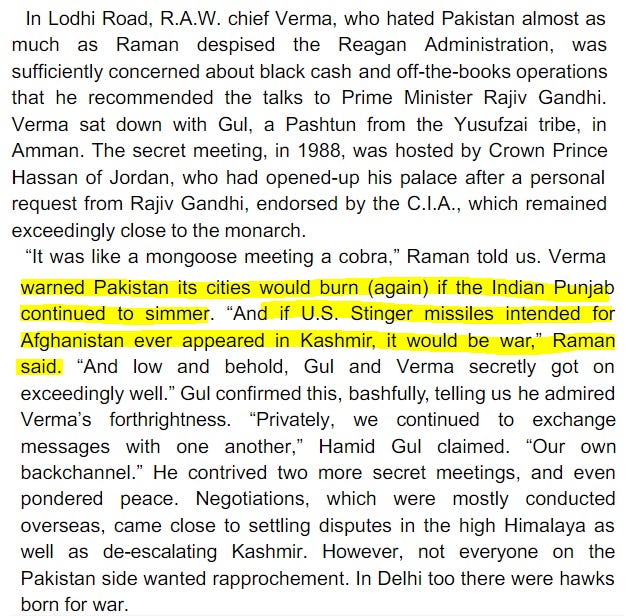
As luck would have it at the height of Kargil war, in May 1999, a Stinger missile was used against India MI-17 gunship. (Source)
Pak Foreign Policy and ISI
Pakistan’s establishment is primarily Army and ISI. These two (although ISI is part of the Army) call the shots within and outside the nation.
Over the years, ISI has fashioned and impacted Pakistan’s Foreign Policy. In fact, Hein Kiessling shares the mind of Hamid Gul on the link between Foreign Office and ISI in the foreign policy turf war.

Over the years this has been borne out by major actions by Pakistan, specifically post 9-11 and the recent US withdrawal from Afghanistan.
Consolidating intelligence apparatus
In the last few years, both India and Pakistan have worked on consolidating their intelligence agencies to better coordinate their functioning.
India had formed the National Security Council (NSC) in 1998. It is the apex body of the three-tiered structure of the national security management system in India. The three tiers are the Strategic Policy Group, the National Security Advisory Board, and a secretariat from the Joint Intelligence Committee. The National Security Advisor (NSA) is the senior official on the National Security Council of India, and the chief adviser to the Prime Minister of India on national security policy and international affairs. The current incumbent is Ajit Doval. The other members of the NSC are - Deputy National Security Advisors, the Ministers of Defence, External Affairs, Home, Finance of the Government of India, and the Vice Chairman of the NITI Aayog.
Within Pakistan, in November 2020, both the military and civilian intelligence agencies were brought under one umbrella. Goal: military’s control over key institutions in Pakistan.
After years of bickering over jurisdiction, Prime Minister Imran Khan approved the setting up of the National Intelligence Coordination Committee (NICC) on Monday, which will bring more than 20 spy agencies under the control of the Inter-Services Intelligence. (Source: Hindustan Times)
This means for Pakistan - that it will be a more closely monitored state. A return to Ayub Khan’s times?
Pakistan’s New US Espionage Channels
And, in recent times, Pakistani ISI has also been making deeper inroads into the US establishment and through them into the Indian institutions in a very different way.
The think tanks and conference circuits.
In 2011, Ghulam Nabi Fai was arrested by the FBI. He was hosting numerous Indian and Pakistan “intellectuals” in conferences dictated by Pakistan’s ISI.
Fai, 62, was arrested by the Federal Bureau of Investigations (FBI) from his house in Fairfax in Virginia, an affluent suburb of Washington D.C., on charges of receiving hundreds and thousands of dollars from the ISI and using them for lobbying at the Capitol Hill and holding seminars and conferences. According to the 43-page FBI affidavit submitted to a US court, the ISI not only funded his Kashmir American Council (KAC), which was run from its headquartered in Washington, but also dictated his speeches, determined who was to be invited to the conferences and even the results. (Source)
These were some of the people who had been regulars of the Fai circuit:
Justice Rajinder Sachar, author of the famous Sachar Committee Report;
Dileep Padgaonkar, one of the three interlocutors on J&K appointed by the central government
Harish Khare, the media adviser to MMS;
Rita Manchanda, the India/Pakistan Local Partner for Women Waging Peace;
Ved Bhasin, editor, Kashmir Times;
Harinder Baweja, editor (investigations), Headlines Today;
Gautam Navlakha and Kamal Chenoy, involved in Bhima-Koregaon and Modi assassination plot
Praful Bidwai, a well-known columnist.
These were primarily attempts at infiltrating India and its media and educational institutions.
Recently, however, the nature of Pakistan’s agents has been different. It is a more direct manifestation of the establishment’s foreign policy.
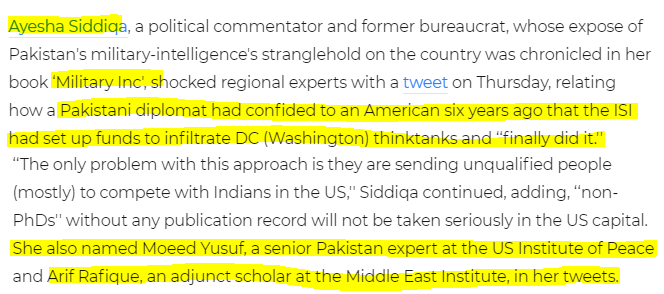
This Moeed Yusuf, who was part of a US taxpayer-funded Government think tank, is now the National Security Advisor to Pakistan PM Imran Khan.
Was he a mole?
USIP had behaved in a very shady manner with respect to the work by Moeed Yusuf. A series of tweets by Christine Fair had shared the mess there, but she has since deleted them. However, we captured it in our blog. (The “she” in the first tweet is the Vice President of USIP Jill Welch.)
Now post US withdrawal from Afghanistan, the Pakistan-US collaboration to install Taliban, a force backed by Khalilzad and Pakistan, these inroads make complete sense.
Espionage is critical to the survival of any nation. ISI has played its cards using its geopolitical location well. India’s R&AW, however, has been repeatedly betrayed by its leaders and politicians. Unless the intelligence apparatus is strengthened to be the best in the world, India’s security will be under threat. Specifically from the fault-lines that Cawthorne had identified way back in 1948!
market corner: 10 quick bytes
Govt to borrow Rs 5.03 lakh crore in H2 FY'22 to fund revenue gap (Source)
At Rs 5 trillion, Adani is now Asia's 2nd richest: IIFL Wealth-Hurun India report (Source) / Mukesh Ambani dominates as richest Indian for 10th year, Adani earned Rs 1,002 crore per day (Source)
WhatsApp: Facebook’s messaging app lets users make QR code payments to millions of stores in India (Source)
Nearly 17 mn tonnes of surplus foodgrains to be used for ethanol making: Food Secy (Source)
Tea Research Institute to sign research MoU with Patanjali (Source)
Bitcoin’s dominance in global crypto market contracts; share in total crypto market cap down by 41% this year (Source)
Myanmar's junta powerless as the currency drops 60% in four weeks, economy tanks (Source)
Govt launches web portal to find solutions to India's waste problems (Source)
DoT cancels 71 letters of intent for providing net service as virtual network operators (Source)
Fundraise of $200 Mn triples Ola Electric valuation to $3 billion (Source)
nota bene
India’s Start-up Ecosystem: India hosts the third-largest startup ecosystem globally. Over the last decade, the consistent growth of this ecosystem has resulted in 55,000 startups that have created $350 billion of value and employing over 1.5 million people. Indian startups have raised over $70 billion from 2014-2020, $11.5 billion in 2020, and $10.5 billion in the first half of 2021 alone, a period overlapping with the Covid-19 pandemic. Industry participants and observers marked a new record in the Indian ecosystem in 2020 for unicorn creation, with 11 startups reaching the milestone. The new year has only seen an acceleration, with 6 unicorns born in one week and 18 created in just H1 2021, with an expectation of 25 more established and 70 total by the year-end. The ecosystem has been on a compounding evolution for over a decade and is built on top of pillars such as India Stack and the Digital Public Goods (DPGs), as well as innovations in low-cost internet access. (Source)
China’s BRI has left 42 nations with debts: China outspends the US and other major powers by at least 2:1 in its Belt and Road Initiative (BRI) international development finance projects, spending a whopping $85 billion annually. But Chinese debt trap is real: 42 countries now have levels of public debt exposure to China in excess of 10% of GDP. According to a study by AidData released today titled, “Banking on the Belt and Road: Insights from a New Global Dataset of 13,427 Chinese Development Projects,” “35% of the BRI infrastructure project portfolio has encountered major implementation problems, such as corruption scandals, labor violations, environmental hazards, and public protests.” BRI infrastructure projects, says the report, take much longer to be implemented, on an average of 1047 days. (Source)
Walmart’s Vriddhi Scheme for MSMEs: Walmart and Flipkart on Wednesday announced the completion of the first phase of training of more than 2,500 MSMEs under their supplier development program Vriddhi. According to the company, Walmart Vriddhi is a growth and learning platform comprising of training and support for MSMEs and has different phases to give businesses access to advanced business tools and expert consultation to grow in online and offline markets globally. “Walmart has an ongoing commitment of tripling exports from India by 2027 to $10 billion annually, and we look forward to supporting more small businesses in their efforts by providing potential access to online and offline markets in India and globally,” said Leigh Hopkins, Executive Vice President, International Strategy, Development, and Asia Region, Walmart International (Source)
Hong Kong 'BBC' ordered to back China's crackdown: China has further curtailed press freedoms in Hong Kong after staff at the territory’s embattled public broadcaster were forced to support national security laws and the interests of the Chinese government. Radio Television Hong Kong (RTHK), founded in 1928, is the only publicly funded media outlet on Chinese soil and is sometimes compared to the BBC in the UK. RTHK said a detailed document was issued to staff setting out its editorial responsibilities, policies and procedures. It follows criticism in a government review in February. The broadcaster reported the document, issued by management, stressed that RTHK programs must not provoke or deepen hatred, discrimination or hostility towards the Beijing or Hong Kong governments. It states that "under no circumstances should our programs provide a platform to encourage, incite, promote, glorify, endorse or sympathize with any act or activity endangering national security or otherwise contain any contents which are contrary to the interests of national security”. Staff that did not comply risked disciplinary action. (Source)
video corner: Becoming a Tibetan Sanyasin
A society where the youth are excited about walking the spiritual path is a blessed society. This is a beautiful story of a young girl who goes against the wishes of her father to become a Sanyasin or a monk in the local monastery in Tibet.
SUPPORT DRISHTIKONE: If you consider our work important and enriching and would like to contribute to our expenses, please click on the amount below to send in your contribution. You have the option of sending a monthly or a one-time contribution. You can do it in US Dollars or Indian Rupees.
US Dollars: One-Time: $25 . $50 . $100 . $200 || Monthly: $5 . $15 . $25 . 50
Indian Rupees: One Time: Rs 100 . Rs 500 . Rs 1000 . Rs 2500 || Recurring: Rs 100 . Rs 500 . Rs 1000
Pound Sterling: One-Time: £25 . £50 . £100 || Monthly: £10 . £25 . £50
If you like this post - please share it with someone who will appreciate the information shared in this edition.
If you like our newsletter, please share it with your friends and family
Today’s ONLINE PAPER: Check out today’s “The Drishtikone Daily” edition. - THE DRISHTIKONE DAILY
Nuzzle Tweets “newsletter” - with tweets and stories that we read and follow in a day in one compilation on a daily basis -Nuzzle Drishtikone - just another way to keep up with things.





